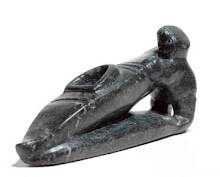
Two posts below I speculated about the tricks King Island kayakers employed to roll their craft. I particularly wondered about paddler/boat connection (required to transmit the forces generated by the former) in such roomy kayaks. Well, the bountiful Net and a bit of luck have greatly cleared that.
Issue #4 of Volume XIII of the Journal of the American Whitewater Affiliation (spring, 1968), contains an article by the late John Heath describing King Island kayaks and kayaking practice. Interesting stuff (for me, at least) is plentiful. Among other things, we are told that King Island paddlers sat upright in the middle of the wide cockpint, without any backrest, and that the kayaker hooked his flexed knees under the deck beam immediately fore of the cockpit to become locked with his boat. One question answered.

Besides, the paper provides a detailed description of the rolling technique, explanatory graphics included. I see little point in my glossing it here for an English-speaking audience that can go directly to the source, but I can say I found it very interesting. Oh, and the rest of the pictures were also most enjoyable. Definitely, recommended reading.

Once again, the Net has come to the rescue of my idle curiosity. And, once again, it has answered one question and prompted several others. Namely, I've learned of another piece by John Heath published in Sea Kayaker in winter 1986 describing the rolling techniques of Nunivak Island and Kotzebue Sound, also in Alaska. To my understanding, Kotzebue Sound is the border between two major kayak types, the relatively short and wide boats of the Bering Sea and Strait to the South, and the long and slender ones of North Alaska to the north and east. I can't help but wondering for which one is the Kotzebue Sound roll. A reference to it being performed with the single-blade paddle, even though the double-bladed one was preferred for most other uses, is intriguing, as North Alaskan kayaks seem to have been paddled mostly with double paddles.
Unfortunately, Sea Kayaker's store seems to have run out of the pertinent issue.







